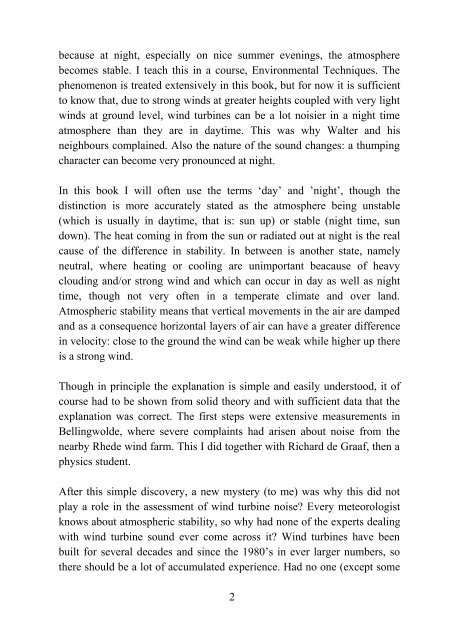The sounds of high winds
The sounds of high winds
The sounds of high winds
You also want an ePaper? Increase the reach of your titles
YUMPU automatically turns print PDFs into web optimized ePapers that Google loves.
ecause at night, especially on nice summer evenings, the atmosphere<br />
becomes stable. I teach this in a course, Environmental Techniques. <strong>The</strong><br />
phenomenon is treated extensively in this book, but for now it is sufficient<br />
to know that, due to strong <strong>winds</strong> at greater heights coupled with very light<br />
<strong>winds</strong> at ground level, wind turbines can be a lot noisier in a night time<br />
atmosphere than they are in daytime. This was why Walter and his<br />
neighbours complained. Also the nature <strong>of</strong> the sound changes: a thumping<br />
character can become very pronounced at night.<br />
In this book I will <strong>of</strong>ten use the terms ‘day’ and ’night’, though the<br />
distinction is more accurately stated as the atmosphere being unstable<br />
(which is usually in daytime, that is: sun up) or stable (night time, sun<br />
down). <strong>The</strong> heat coming in from the sun or radiated out at night is the real<br />
cause <strong>of</strong> the difference in stability. In between is another state, namely<br />
neutral, where heating or cooling are unimportant beacause <strong>of</strong> heavy<br />
clouding and/or strong wind and which can occur in day as well as night<br />
time, though not very <strong>of</strong>ten in a temperate climate and over land.<br />
Atmospheric stability means that vertical movements in the air are damped<br />
and as a consequence horizontal layers <strong>of</strong> air can have a greater difference<br />
in velocity: close to the ground the wind can be weak while <strong>high</strong>er up there<br />
is a strong wind.<br />
Though in principle the explanation is simple and easily understood, it <strong>of</strong><br />
course had to be shown from solid theory and with sufficient data that the<br />
explanation was correct. <strong>The</strong> first steps were extensive measurements in<br />
Bellingwolde, where severe complaints had arisen about noise from the<br />
nearby Rhede wind farm. This I did together with Richard de Graaf, then a<br />
physics student.<br />
After this simple discovery, a new mystery (to me) was why this did not<br />
play a role in the assessment <strong>of</strong> wind turbine noise? Every meteorologist<br />
knows about atmospheric stability, so why had none <strong>of</strong> the experts dealing<br />
with wind turbine sound ever come across it? Wind turbines have been<br />
built for several decades and since the 1980’s in ever larger numbers, so<br />
there should be a lot <strong>of</strong> accumulated experience. Had no one (except some<br />
2
















